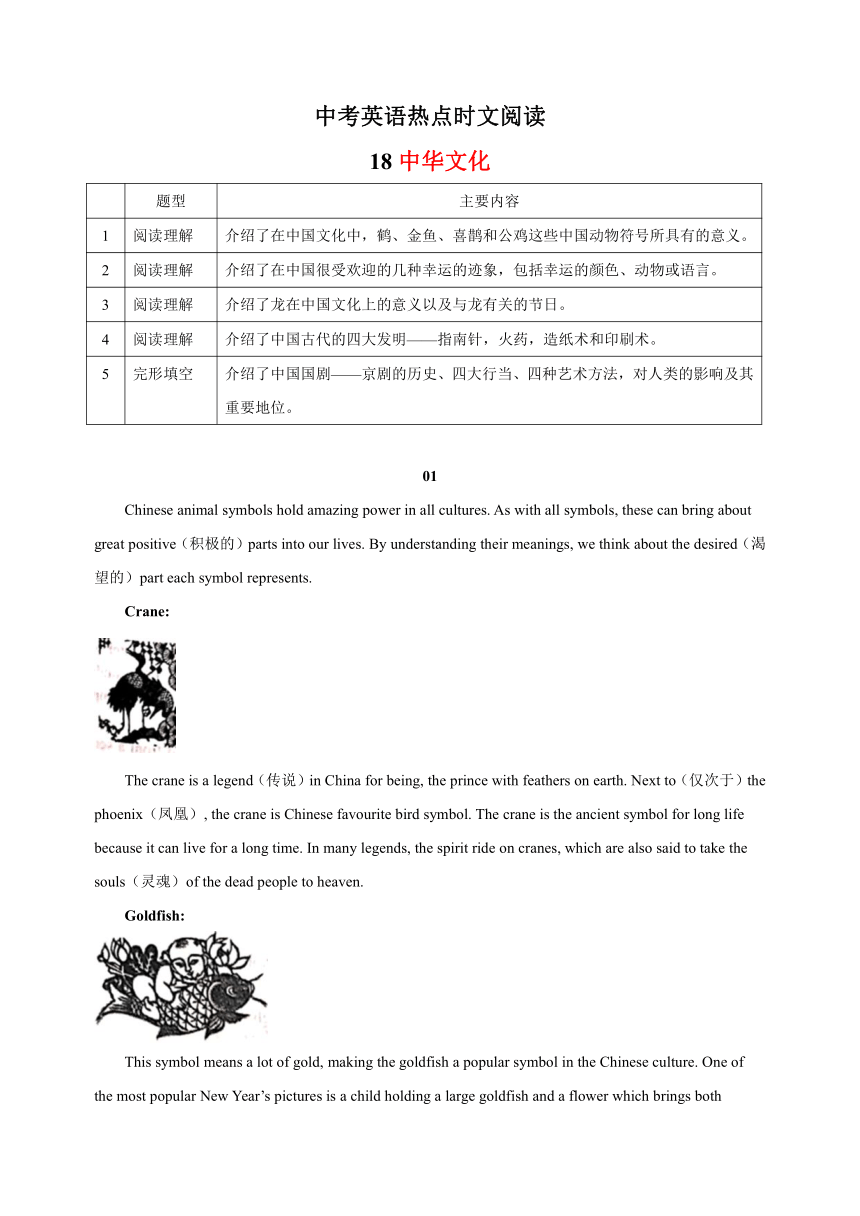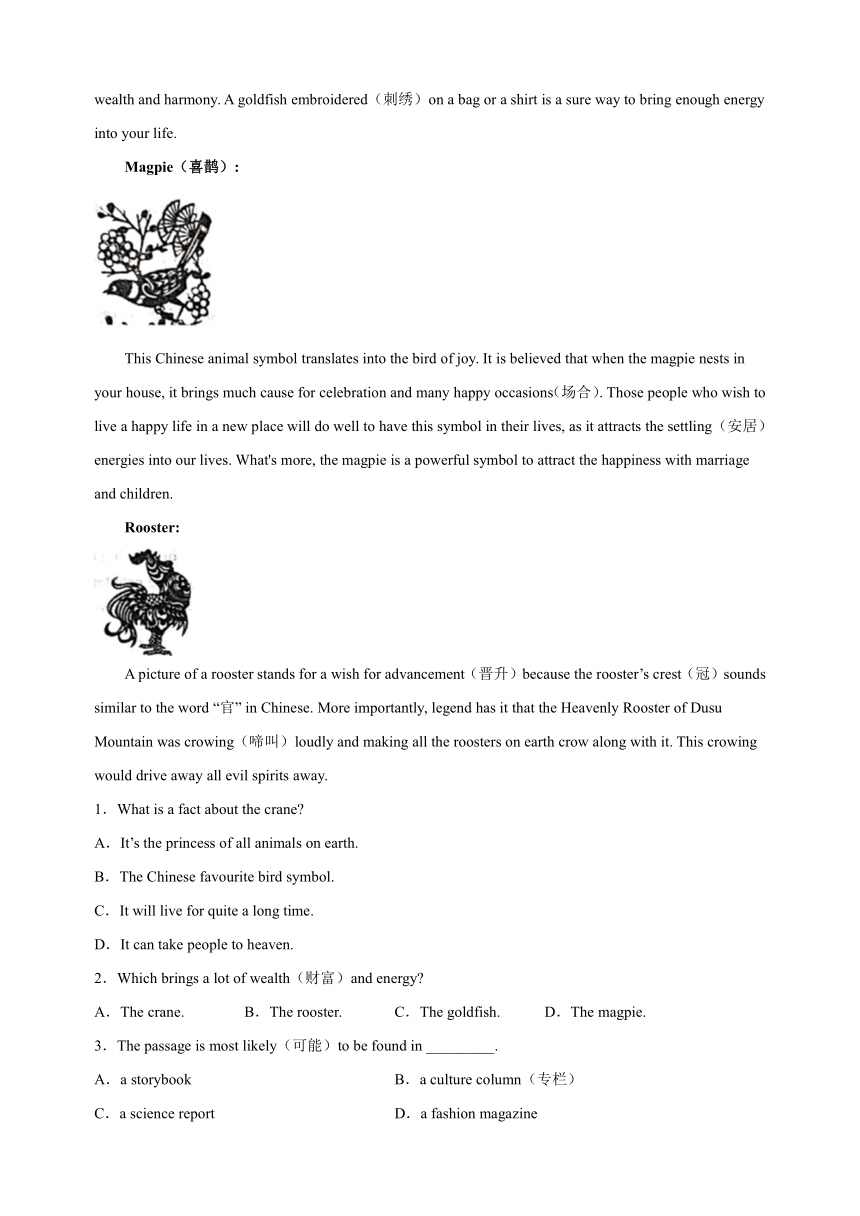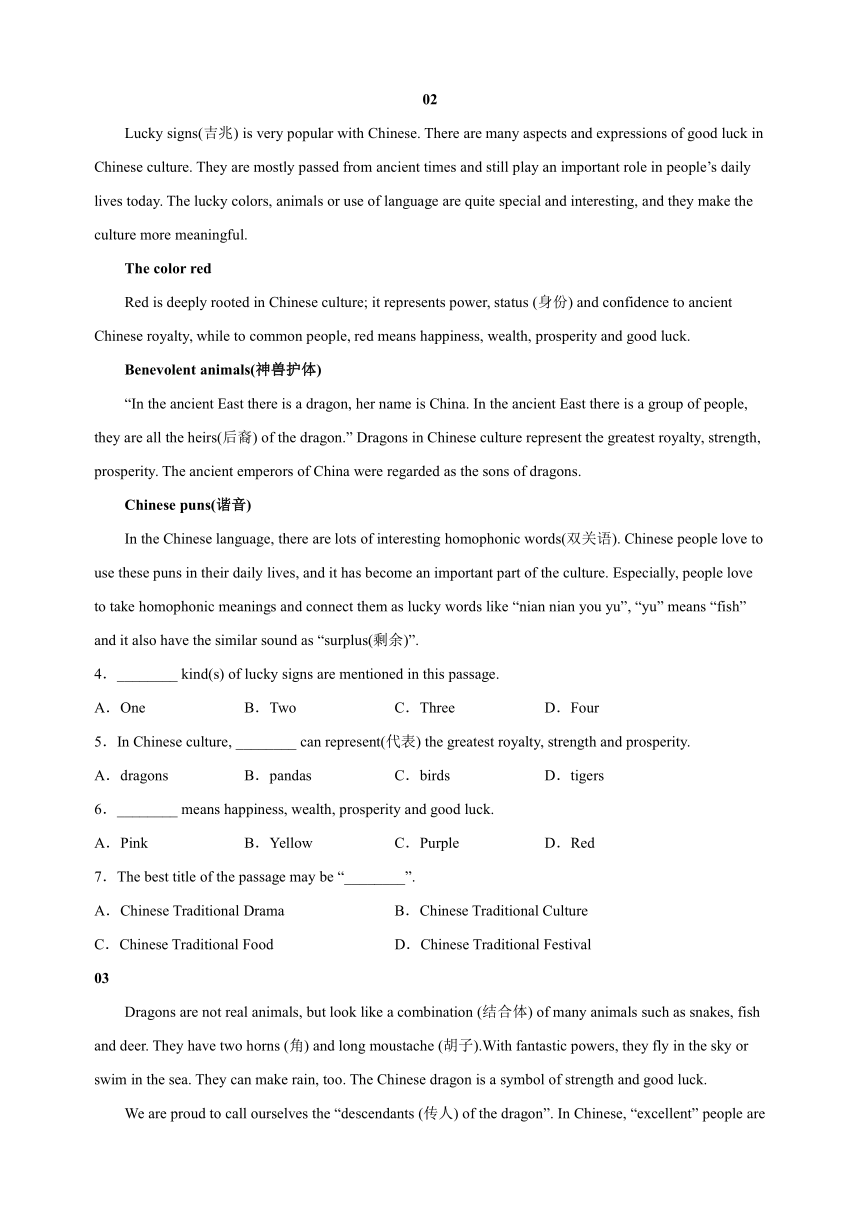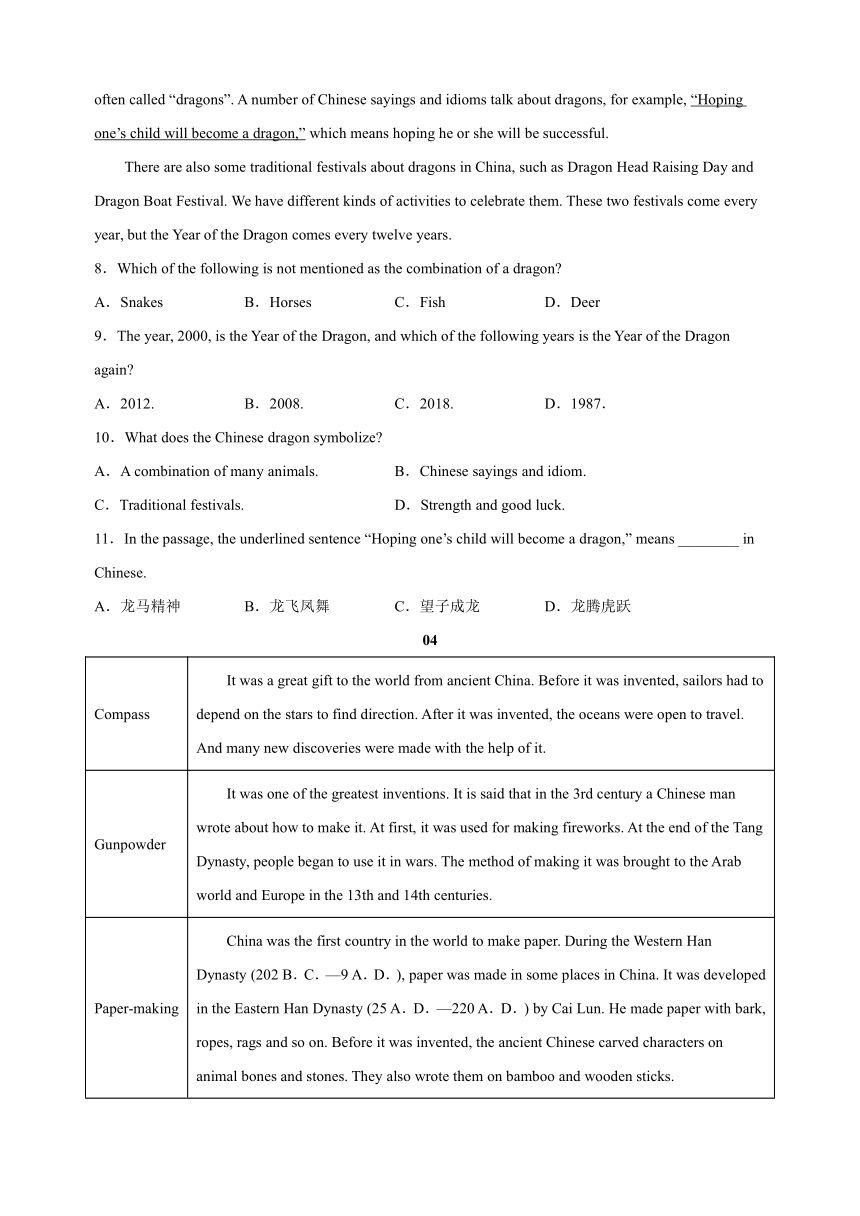18中华文化-中考英语时文阅读练习(含答案解析)
文档属性
| 名称 | 18中华文化-中考英语时文阅读练习(含答案解析) |  | |
| 格式 | doc | ||
| 文件大小 | 349.8KB | ||
| 资源类型 | 教案 | ||
| 版本资源 | 牛津译林版 | ||
| 科目 | 英语 | ||
| 更新时间 | 2024-03-04 12:41:05 | ||
图片预览




文档简介
中考英语热点时文阅读
18中华文化
题型 主要内容
1 阅读理解 介绍了在中国文化中,鹤、金鱼、喜鹊和公鸡这些中国动物符号所具有的意义。
2 阅读理解 介绍了在中国很受欢迎的几种幸运的迹象,包括幸运的颜色、动物或语言。
3 阅读理解 介绍了龙在中国文化上的意义以及与龙有关的节日。
4 阅读理解 介绍了中国古代的四大发明——指南针,火药,造纸术和印刷术。
5 完形填空 介绍了中国国剧——京剧的历史、四大行当、四种艺术方法,对人类的影响及其重要地位。
01
Chinese animal symbols hold amazing power in all cultures. As with all symbols, these can bring about great positive(积极的)parts into our lives. By understanding their meanings, we think about the desired(渴望的)part each symbol represents.
Crane:
The crane is a legend(传说)in China for being, the prince with feathers on earth. Next to(仅次于)the phoenix(凤凰), the crane is Chinese favourite bird symbol. The crane is the ancient symbol for long life because it can live for a long time. In many legends, the spirit ride on cranes, which are also said to take the souls(灵魂)of the dead people to heaven.
Goldfish:
This symbol means a lot of gold, making the goldfish a popular symbol in the Chinese culture. One of the most popular New Year’s pictures is a child holding a large goldfish and a flower which brings both wealth and harmony. A goldfish embroidered(刺绣)on a bag or a shirt is a sure way to bring enough energy into your life.
Magpie(喜鹊):
This Chinese animal symbol translates into the bird of joy. It is believed that when the magpie nests in your house, it brings much cause for celebration and many happy occasions(场合). Those people who wish to live a happy life in a new place will do well to have this symbol in their lives, as it attracts the settling(安居)energies into our lives. What's more, the magpie is a powerful symbol to attract the happiness with marriage and children.
Rooster:
A picture of a rooster stands for a wish for advancement(晋升)because the rooster’s crest(冠)sounds similar to the word “官” in Chinese. More importantly, legend has it that the Heavenly Rooster of Dusu Mountain was crowing(啼叫)loudly and making all the roosters on earth crow along with it. This crowing would drive away all evil spirits away.
1.What is a fact about the crane
A.It’s the princess of all animals on earth.
B.The Chinese favourite bird symbol.
C.It will live for quite a long time.
D.It can take people to heaven.
2.Which brings a lot of wealth(财富)and energy
A.The crane. B.The rooster. C.The goldfish. D.The magpie.
3.The passage is most likely(可能)to be found in _________.
A.a storybook B.a culture column(专栏)
C.a science report D.a fashion magazine
02
Lucky signs(吉兆) is very popular with Chinese. There are many aspects and expressions of good luck in Chinese culture. They are mostly passed from ancient times and still play an important role in people’s daily lives today. The lucky colors, animals or use of language are quite special and interesting, and they make the culture more meaningful.
The color red
Red is deeply rooted in Chinese culture; it represents power, status (身份) and confidence to ancient Chinese royalty, while to common people, red means happiness, wealth, prosperity and good luck.
Benevolent animals(神兽护体)
“In the ancient East there is a dragon, her name is China. In the ancient East there is a group of people, they are all the heirs(后裔) of the dragon.” Dragons in Chinese culture represent the greatest royalty, strength, prosperity. The ancient emperors of China were regarded as the sons of dragons.
Chinese puns(谐音)
In the Chinese language, there are lots of interesting homophonic words(双关语). Chinese people love to use these puns in their daily lives, and it has become an important part of the culture. Especially, people love to take homophonic meanings and connect them as lucky words like “nian nian you yu”, “yu” means “fish” and it also have the similar sound as “surplus(剩余)”.
4.________ kind(s) of lucky signs are mentioned in this passage.
A.One B.Two C.Three D.Four
5.In Chinese culture, ________ can represent(代表) the greatest royalty, strength and prosperity.
A.dragons B.pandas C.birds D.tigers
6.________ means happiness, wealth, prosperity and good luck.
A.Pink B.Yellow C.Purple D.Red
7.The best title of the passage may be “________”.
A.Chinese Traditional Drama B.Chinese Traditional Culture
C.Chinese Traditional Food D.Chinese Traditional Festival
03
Dragons are not real animals, but look like a combination (结合体) of many animals such as snakes, fish and deer. They have two horns (角) and long moustache (胡子).With fantastic powers, they fly in the sky or swim in the sea. They can make rain, too. The Chinese dragon is a symbol of strength and good luck.
We are proud to call ourselves the “descendants (传人) of the dragon”. In Chinese, “excellent” people are often called “dragons”. A number of Chinese sayings and idioms talk about dragons, for example, “Hoping one’s child will become a dragon,” which means hoping he or she will be successful.
There are also some traditional festivals about dragons in China, such as Dragon Head Raising Day and Dragon Boat Festival. We have different kinds of activities to celebrate them. These two festivals come every year, but the Year of the Dragon comes every twelve years.
8.Which of the following is not mentioned as the combination of a dragon
A.Snakes B.Horses C.Fish D.Deer
9.The year, 2000, is the Year of the Dragon, and which of the following years is the Year of the Dragon again
A.2012. B.2008. C.2018. D.1987.
10.What does the Chinese dragon symbolize
A.A combination of many animals. B.Chinese sayings and idiom.
C.Traditional festivals. D.Strength and good luck.
11.In the passage, the underlined sentence “Hoping one’s child will become a dragon,” means ________ in Chinese.
A.龙马精神 B.龙飞凤舞 C.望子成龙 D.龙腾虎跃
04
Compass It was a great gift to the world from ancient China. Before it was invented, sailors had to depend on the stars to find direction. After it was invented, the oceans were open to travel. And many new discoveries were made with the help of it.
Gunpowder It was one of the greatest inventions. It is said that in the 3rd century a Chinese man wrote about how to make it. At first, it was used for making fireworks. At the end of the Tang Dynasty, people began to use it in wars. The method of making it was brought to the Arab world and Europe in the 13th and 14th centuries.
Paper-making China was the first country in the world to make paper. During the Western Han Dynasty (202 B.C.—9 A.D.), paper was made in some places in China. It was developed in the Eastern Han Dynasty (25 A.D.—220 A.D.) by Cai Lun. He made paper with bark, ropes, rags and so on. Before it was invented, the ancient Chinese carved characters on animal bones and stones. They also wrote them on bamboo and wooden sticks.
Printing It was developed in 1041—1048 in the Song Dynasty. A man named Bi Sheng carved characters on pieces of clay and wood. Then he put ink on them. After the characters were printed on paper, the pieces of clay or wood could be used again. This technology then spread to Korea, Japan and Europe. It was the basic method at that time.
12.After the ________ was invented, the oceans were open to travel.
A.compass B.printing C.gunpowder D.paper-making
13.At first, gunpowder was used for ________.
A.finding direction B.making fireworks
C.carving characters D.writing characters
14.________ developed paper-making in the Eastern Han Dynasty.
A.Some sailors B.Bi Sheng C.Cai Lun D.People in the Arab world
15.Printing was developed in the ________.
A.Tang Dynasty B.Song Dynasty C.Han Dynasty D.We don’t know.
16.The best title for the reading material is ________.
A.The Four Dynasties of Ancient China
B.The Four Great Inventors of Ancient China
C.The Four Great Inventions of Ancient China
D.The Four Great Inventions of China
05
Beijing Opera is our national opera. It has a quite long history. It is the soul(灵魂)of Chinese national culture. It came into being(形成)after 1790 when the famous four Anhui opera troupes(戏班)___17___ to Beijing. Beijing Opera is ___18___ of historical stories, beautiful costumes and wonderful performances.
Its music and singing came from Xipi and Erhuang in Anhui and Hubei. There are mainly ___19___kinds of roles in Beijing Opera: Sheng, Dan, Jing and Chou. The Sheng is a ___20___ male actor. The Dan is a female role. The Jing is a male role ___21___ a painted face and the Chou is a comedy actor.
Beijing Opera presents plays and characters mainly by four artistic ___22___. They are singing, speaking, acting and martial arts(唱、念、做、打). These methods make audience(观众)to be encouraged by the performers’ feelings, language, music and action.
Beijing Opera is ___23___ by generations(代)of Chinese people. Today, an increasing number of young people are becoming ___24___ in it. Foreign people are also visiting China to ___25___ Beijing Opera.
Beijing Opera contains the soul of Chinese national culture. Its special charm(魅力)____26____ generations of Chinese people. There is no doubt that it is really the treasure of Chinese culture.
17.A.came B.left C.arrived D.reached
18.A.full B.sure C.proud D.careful
19.A.three B.four C.two D.five
20.A.ugly B.leading C.smart D.strange
21.A.in B.with C.of D.under
22.A.shows B.methods C.scenes D.works
23.A.enjoyed B.written C.called D.made
24.A.experienced B.interested C.weak D.rich
25.A.eat B.drink C.taste D.hurt
26.A.insists B.shows C.tells D.encourages
参考答案
1.C 2.C 3.B
【导语】本文介绍了在中国文化中,鹤、金鱼、喜鹊和公鸡这些中国动物符号所具有的意义。
1.细节理解题。根据“The crane is the ancient symbol for long life because it can live for a long time.”可知,鹤是长寿的古老象征,因为它可以活很长时间。故选C。
2.推理判断题。根据“One of the most popular New Year’s pictures is a child holding a large goldfish and a flower which brings both wealth and harmony. A goldfish embroidered on a bag or a shirt is a sure way to bring enough energy into your life.”可知,金鱼会带来了许多财富和能量,故选C。
3.推理判断题。根据“Chinese animal symbols hold amazing power in all cultures. As with all symbols, these can bring about great positive parts into our lives. By understanding their meanings, we think about the desired part each symbol represents.”可知,本文介绍了中国的动物符号在所有文化中都具有神奇的力量,因此本文可能在文化专栏被看见,故选B。
4.C 5.A 6.D 7.B
【导语】本文介绍了在中国很受欢迎的几种幸运的迹象,包括幸运的颜色、动物或语言。
4.细节理解题。根据“The color red”;“Benevolent animals”以及“Chinese puns”可知,文中提到了三种幸运的迹象,故选C。
5.细节理解题。根据文中“Dragons in Chinese culture represent the greatest royalty, strength, prosperity.”可知,龙在中国文化中代表着至高无上的王权、力量和繁荣,故选A。
6.细节理解题。根据“Red is deeply rooted in Chinese culture...while to common people, red means happiness, wealth, prosperity and good luck.”可知,红色意味着幸福、财富、繁荣和好运,故选D。
7.最佳标题题。根据“Lucky signs is very popular with Chinese. There are many aspects and expressions of good luck in Chinese culture...and they make the culture more meaningful.”及整个文章的理解可知,文章主要是介绍中国传统文化中一些象征幸运的迹象,包括幸运的颜色、动物或语言,故选B。
8.B 9.A 10.D 11.C
【导语】本文主要介绍了龙在中国文化上的意义以及与龙有关的节日。
8.细节理解题。根据“Dragons are not real animals, but look like a combination (结合体) of many animals such as snakes, fish and deer”可知,是蛇,鱼和鹿的结合体,没有提到马,故选B。
9.推理判断题。根据“but the Year of the Dragon comes every twelve years”可知,龙年每十二年一次,所以2000年是龙年,2012年也是龙年,故选A。
10.细节理解题。根据“The Chinese dragon is a symbol of strength and good luck”可知,中国龙是力量和好运的象征,故选D。
11.句意猜测题。根据“which means hoping he or she will be successful”可知,这句话是希望孩子成功,也就是“望子成龙”,故选C。
12.A 13.B 14.C 15.B 16.C
【导语】本文主要介绍了中国古代的四大发明——指南针,火药,造纸术和印刷术。
12.细节理解题。根据“Compass;After it was invented, the oceans were open to travel.”可知,指南针发明后,航海变得更加开放。故选A。
13.细节理解题。根据“Gunpowder;At first, it was used for making fireworks.”可知,在一开始,火药是用来制作烟花。故选B。
14.细节理解题。根据“Paper-making;It was developed in the Eastern Han Dynasty (25 A.D.—220 A.D.) by Cai Lun.”可知,蔡伦在东汉年间改良造纸术。故选C。
15.细节理解题。根据“Printing;It was developed in 1041—1048 in the Song Dynasty.”可知,印刷术是在宋代被发明的。故选B。
16.最佳标题题。通读全文可知,本文主要介绍了中国古代的四大发明。故选C。
17.A 18.A 19.B 20.B 21.B 22.B 23.A 24.B 25.C 26.D
【导语】本文主要介绍了中国国剧——京剧的历史、四大行当、四种艺术方法,对人类的影响及其重要地位。
17.句意:它形成于1790年之后,当时著名的四个安徽戏班来到北京。
came来到;left离开;arrived抵达;reached达到。leave和reach为及物动词,后面直接加名词,故排除BC;arrive at/in sp.“到达某地”,通常不与to连用,故排除C;come to sp.“来到某地”,符合语境。故选A。
18.句意:京剧充满了历史故事、美丽的服装和精彩的表演。
full满的;sure确信的;proud自豪的;careful仔细的。be full of“充满”,固定短语。故选A。
19.句意:京剧主要有生、旦、净、丑四种行当。
three三;four四;two二;five五。根据“Sheng, Dan, Jing and Chou”可知,是四种行当。故选B。
20.句意:“生”是男主角。
ugly丑的;leading最重要的;smart聪明的;strange奇怪的。根据常识可知,“生”是京剧中最重要的角色。故选B。
21.句意:“净”是脸部彩绘的男性角色,“丑”是喜剧演员。
in在……内;with具有;of属于;under在……下面。根据“The Jing is a male role...a painted face”可知,此处表示“净”这个角色的特征,用with表示“具有”。故选B。
22.句意:京剧主要通过四种艺术方法呈现戏剧和人物。
shows表演;methods方法;scenes场景;works作品。根据下文“These methods make audience...”可知,此处指四种艺术方法。故选B。
23.句意:京剧深受几代中国人的喜爱。
enjoyed喜爱;written书面的;called叫作;made制成的。根据“Beijing Opera is...by generations of Chinese people.”可知,此处为被动语态,表示被几代中国人所喜爱。故选A。
24.句意:今天,越来越多的年轻人对它感兴趣。
experienced有经验的;interested感兴趣的;weak虚弱的;rich富有的。be interested in sth.“对某事感兴趣”,含有形容词“interested”的固定短语。故选B。
25.句意:外国人也来到中国去体验京剧。
eat吃;drink喝;taste体验;hurt使受伤。根据“Foreign people are also visiting China to...Beijing Opera.”可知,此处指体验京剧,动词不定式作目的状语。故选C。
26.句意:它独特的魅力激励着一代又一代中国人。
insists坚持;shows显示;tells告诉;encourages激励。根据“Its special charm...generations of Chinese people.”可知,主语为“Its special charm”,空处为动词,“generations of Chinese people”为宾语,结合选项可知,“encourages”符合语境,表示它的独特魅力激励着中国人。故选D。
18中华文化
题型 主要内容
1 阅读理解 介绍了在中国文化中,鹤、金鱼、喜鹊和公鸡这些中国动物符号所具有的意义。
2 阅读理解 介绍了在中国很受欢迎的几种幸运的迹象,包括幸运的颜色、动物或语言。
3 阅读理解 介绍了龙在中国文化上的意义以及与龙有关的节日。
4 阅读理解 介绍了中国古代的四大发明——指南针,火药,造纸术和印刷术。
5 完形填空 介绍了中国国剧——京剧的历史、四大行当、四种艺术方法,对人类的影响及其重要地位。
01
Chinese animal symbols hold amazing power in all cultures. As with all symbols, these can bring about great positive(积极的)parts into our lives. By understanding their meanings, we think about the desired(渴望的)part each symbol represents.
Crane:
The crane is a legend(传说)in China for being, the prince with feathers on earth. Next to(仅次于)the phoenix(凤凰), the crane is Chinese favourite bird symbol. The crane is the ancient symbol for long life because it can live for a long time. In many legends, the spirit ride on cranes, which are also said to take the souls(灵魂)of the dead people to heaven.
Goldfish:
This symbol means a lot of gold, making the goldfish a popular symbol in the Chinese culture. One of the most popular New Year’s pictures is a child holding a large goldfish and a flower which brings both wealth and harmony. A goldfish embroidered(刺绣)on a bag or a shirt is a sure way to bring enough energy into your life.
Magpie(喜鹊):
This Chinese animal symbol translates into the bird of joy. It is believed that when the magpie nests in your house, it brings much cause for celebration and many happy occasions(场合). Those people who wish to live a happy life in a new place will do well to have this symbol in their lives, as it attracts the settling(安居)energies into our lives. What's more, the magpie is a powerful symbol to attract the happiness with marriage and children.
Rooster:
A picture of a rooster stands for a wish for advancement(晋升)because the rooster’s crest(冠)sounds similar to the word “官” in Chinese. More importantly, legend has it that the Heavenly Rooster of Dusu Mountain was crowing(啼叫)loudly and making all the roosters on earth crow along with it. This crowing would drive away all evil spirits away.
1.What is a fact about the crane
A.It’s the princess of all animals on earth.
B.The Chinese favourite bird symbol.
C.It will live for quite a long time.
D.It can take people to heaven.
2.Which brings a lot of wealth(财富)and energy
A.The crane. B.The rooster. C.The goldfish. D.The magpie.
3.The passage is most likely(可能)to be found in _________.
A.a storybook B.a culture column(专栏)
C.a science report D.a fashion magazine
02
Lucky signs(吉兆) is very popular with Chinese. There are many aspects and expressions of good luck in Chinese culture. They are mostly passed from ancient times and still play an important role in people’s daily lives today. The lucky colors, animals or use of language are quite special and interesting, and they make the culture more meaningful.
The color red
Red is deeply rooted in Chinese culture; it represents power, status (身份) and confidence to ancient Chinese royalty, while to common people, red means happiness, wealth, prosperity and good luck.
Benevolent animals(神兽护体)
“In the ancient East there is a dragon, her name is China. In the ancient East there is a group of people, they are all the heirs(后裔) of the dragon.” Dragons in Chinese culture represent the greatest royalty, strength, prosperity. The ancient emperors of China were regarded as the sons of dragons.
Chinese puns(谐音)
In the Chinese language, there are lots of interesting homophonic words(双关语). Chinese people love to use these puns in their daily lives, and it has become an important part of the culture. Especially, people love to take homophonic meanings and connect them as lucky words like “nian nian you yu”, “yu” means “fish” and it also have the similar sound as “surplus(剩余)”.
4.________ kind(s) of lucky signs are mentioned in this passage.
A.One B.Two C.Three D.Four
5.In Chinese culture, ________ can represent(代表) the greatest royalty, strength and prosperity.
A.dragons B.pandas C.birds D.tigers
6.________ means happiness, wealth, prosperity and good luck.
A.Pink B.Yellow C.Purple D.Red
7.The best title of the passage may be “________”.
A.Chinese Traditional Drama B.Chinese Traditional Culture
C.Chinese Traditional Food D.Chinese Traditional Festival
03
Dragons are not real animals, but look like a combination (结合体) of many animals such as snakes, fish and deer. They have two horns (角) and long moustache (胡子).With fantastic powers, they fly in the sky or swim in the sea. They can make rain, too. The Chinese dragon is a symbol of strength and good luck.
We are proud to call ourselves the “descendants (传人) of the dragon”. In Chinese, “excellent” people are often called “dragons”. A number of Chinese sayings and idioms talk about dragons, for example, “Hoping one’s child will become a dragon,” which means hoping he or she will be successful.
There are also some traditional festivals about dragons in China, such as Dragon Head Raising Day and Dragon Boat Festival. We have different kinds of activities to celebrate them. These two festivals come every year, but the Year of the Dragon comes every twelve years.
8.Which of the following is not mentioned as the combination of a dragon
A.Snakes B.Horses C.Fish D.Deer
9.The year, 2000, is the Year of the Dragon, and which of the following years is the Year of the Dragon again
A.2012. B.2008. C.2018. D.1987.
10.What does the Chinese dragon symbolize
A.A combination of many animals. B.Chinese sayings and idiom.
C.Traditional festivals. D.Strength and good luck.
11.In the passage, the underlined sentence “Hoping one’s child will become a dragon,” means ________ in Chinese.
A.龙马精神 B.龙飞凤舞 C.望子成龙 D.龙腾虎跃
04
Compass It was a great gift to the world from ancient China. Before it was invented, sailors had to depend on the stars to find direction. After it was invented, the oceans were open to travel. And many new discoveries were made with the help of it.
Gunpowder It was one of the greatest inventions. It is said that in the 3rd century a Chinese man wrote about how to make it. At first, it was used for making fireworks. At the end of the Tang Dynasty, people began to use it in wars. The method of making it was brought to the Arab world and Europe in the 13th and 14th centuries.
Paper-making China was the first country in the world to make paper. During the Western Han Dynasty (202 B.C.—9 A.D.), paper was made in some places in China. It was developed in the Eastern Han Dynasty (25 A.D.—220 A.D.) by Cai Lun. He made paper with bark, ropes, rags and so on. Before it was invented, the ancient Chinese carved characters on animal bones and stones. They also wrote them on bamboo and wooden sticks.
Printing It was developed in 1041—1048 in the Song Dynasty. A man named Bi Sheng carved characters on pieces of clay and wood. Then he put ink on them. After the characters were printed on paper, the pieces of clay or wood could be used again. This technology then spread to Korea, Japan and Europe. It was the basic method at that time.
12.After the ________ was invented, the oceans were open to travel.
A.compass B.printing C.gunpowder D.paper-making
13.At first, gunpowder was used for ________.
A.finding direction B.making fireworks
C.carving characters D.writing characters
14.________ developed paper-making in the Eastern Han Dynasty.
A.Some sailors B.Bi Sheng C.Cai Lun D.People in the Arab world
15.Printing was developed in the ________.
A.Tang Dynasty B.Song Dynasty C.Han Dynasty D.We don’t know.
16.The best title for the reading material is ________.
A.The Four Dynasties of Ancient China
B.The Four Great Inventors of Ancient China
C.The Four Great Inventions of Ancient China
D.The Four Great Inventions of China
05
Beijing Opera is our national opera. It has a quite long history. It is the soul(灵魂)of Chinese national culture. It came into being(形成)after 1790 when the famous four Anhui opera troupes(戏班)___17___ to Beijing. Beijing Opera is ___18___ of historical stories, beautiful costumes and wonderful performances.
Its music and singing came from Xipi and Erhuang in Anhui and Hubei. There are mainly ___19___kinds of roles in Beijing Opera: Sheng, Dan, Jing and Chou. The Sheng is a ___20___ male actor. The Dan is a female role. The Jing is a male role ___21___ a painted face and the Chou is a comedy actor.
Beijing Opera presents plays and characters mainly by four artistic ___22___. They are singing, speaking, acting and martial arts(唱、念、做、打). These methods make audience(观众)to be encouraged by the performers’ feelings, language, music and action.
Beijing Opera is ___23___ by generations(代)of Chinese people. Today, an increasing number of young people are becoming ___24___ in it. Foreign people are also visiting China to ___25___ Beijing Opera.
Beijing Opera contains the soul of Chinese national culture. Its special charm(魅力)____26____ generations of Chinese people. There is no doubt that it is really the treasure of Chinese culture.
17.A.came B.left C.arrived D.reached
18.A.full B.sure C.proud D.careful
19.A.three B.four C.two D.five
20.A.ugly B.leading C.smart D.strange
21.A.in B.with C.of D.under
22.A.shows B.methods C.scenes D.works
23.A.enjoyed B.written C.called D.made
24.A.experienced B.interested C.weak D.rich
25.A.eat B.drink C.taste D.hurt
26.A.insists B.shows C.tells D.encourages
参考答案
1.C 2.C 3.B
【导语】本文介绍了在中国文化中,鹤、金鱼、喜鹊和公鸡这些中国动物符号所具有的意义。
1.细节理解题。根据“The crane is the ancient symbol for long life because it can live for a long time.”可知,鹤是长寿的古老象征,因为它可以活很长时间。故选C。
2.推理判断题。根据“One of the most popular New Year’s pictures is a child holding a large goldfish and a flower which brings both wealth and harmony. A goldfish embroidered on a bag or a shirt is a sure way to bring enough energy into your life.”可知,金鱼会带来了许多财富和能量,故选C。
3.推理判断题。根据“Chinese animal symbols hold amazing power in all cultures. As with all symbols, these can bring about great positive parts into our lives. By understanding their meanings, we think about the desired part each symbol represents.”可知,本文介绍了中国的动物符号在所有文化中都具有神奇的力量,因此本文可能在文化专栏被看见,故选B。
4.C 5.A 6.D 7.B
【导语】本文介绍了在中国很受欢迎的几种幸运的迹象,包括幸运的颜色、动物或语言。
4.细节理解题。根据“The color red”;“Benevolent animals”以及“Chinese puns”可知,文中提到了三种幸运的迹象,故选C。
5.细节理解题。根据文中“Dragons in Chinese culture represent the greatest royalty, strength, prosperity.”可知,龙在中国文化中代表着至高无上的王权、力量和繁荣,故选A。
6.细节理解题。根据“Red is deeply rooted in Chinese culture...while to common people, red means happiness, wealth, prosperity and good luck.”可知,红色意味着幸福、财富、繁荣和好运,故选D。
7.最佳标题题。根据“Lucky signs is very popular with Chinese. There are many aspects and expressions of good luck in Chinese culture...and they make the culture more meaningful.”及整个文章的理解可知,文章主要是介绍中国传统文化中一些象征幸运的迹象,包括幸运的颜色、动物或语言,故选B。
8.B 9.A 10.D 11.C
【导语】本文主要介绍了龙在中国文化上的意义以及与龙有关的节日。
8.细节理解题。根据“Dragons are not real animals, but look like a combination (结合体) of many animals such as snakes, fish and deer”可知,是蛇,鱼和鹿的结合体,没有提到马,故选B。
9.推理判断题。根据“but the Year of the Dragon comes every twelve years”可知,龙年每十二年一次,所以2000年是龙年,2012年也是龙年,故选A。
10.细节理解题。根据“The Chinese dragon is a symbol of strength and good luck”可知,中国龙是力量和好运的象征,故选D。
11.句意猜测题。根据“which means hoping he or she will be successful”可知,这句话是希望孩子成功,也就是“望子成龙”,故选C。
12.A 13.B 14.C 15.B 16.C
【导语】本文主要介绍了中国古代的四大发明——指南针,火药,造纸术和印刷术。
12.细节理解题。根据“Compass;After it was invented, the oceans were open to travel.”可知,指南针发明后,航海变得更加开放。故选A。
13.细节理解题。根据“Gunpowder;At first, it was used for making fireworks.”可知,在一开始,火药是用来制作烟花。故选B。
14.细节理解题。根据“Paper-making;It was developed in the Eastern Han Dynasty (25 A.D.—220 A.D.) by Cai Lun.”可知,蔡伦在东汉年间改良造纸术。故选C。
15.细节理解题。根据“Printing;It was developed in 1041—1048 in the Song Dynasty.”可知,印刷术是在宋代被发明的。故选B。
16.最佳标题题。通读全文可知,本文主要介绍了中国古代的四大发明。故选C。
17.A 18.A 19.B 20.B 21.B 22.B 23.A 24.B 25.C 26.D
【导语】本文主要介绍了中国国剧——京剧的历史、四大行当、四种艺术方法,对人类的影响及其重要地位。
17.句意:它形成于1790年之后,当时著名的四个安徽戏班来到北京。
came来到;left离开;arrived抵达;reached达到。leave和reach为及物动词,后面直接加名词,故排除BC;arrive at/in sp.“到达某地”,通常不与to连用,故排除C;come to sp.“来到某地”,符合语境。故选A。
18.句意:京剧充满了历史故事、美丽的服装和精彩的表演。
full满的;sure确信的;proud自豪的;careful仔细的。be full of“充满”,固定短语。故选A。
19.句意:京剧主要有生、旦、净、丑四种行当。
three三;four四;two二;five五。根据“Sheng, Dan, Jing and Chou”可知,是四种行当。故选B。
20.句意:“生”是男主角。
ugly丑的;leading最重要的;smart聪明的;strange奇怪的。根据常识可知,“生”是京剧中最重要的角色。故选B。
21.句意:“净”是脸部彩绘的男性角色,“丑”是喜剧演员。
in在……内;with具有;of属于;under在……下面。根据“The Jing is a male role...a painted face”可知,此处表示“净”这个角色的特征,用with表示“具有”。故选B。
22.句意:京剧主要通过四种艺术方法呈现戏剧和人物。
shows表演;methods方法;scenes场景;works作品。根据下文“These methods make audience...”可知,此处指四种艺术方法。故选B。
23.句意:京剧深受几代中国人的喜爱。
enjoyed喜爱;written书面的;called叫作;made制成的。根据“Beijing Opera is...by generations of Chinese people.”可知,此处为被动语态,表示被几代中国人所喜爱。故选A。
24.句意:今天,越来越多的年轻人对它感兴趣。
experienced有经验的;interested感兴趣的;weak虚弱的;rich富有的。be interested in sth.“对某事感兴趣”,含有形容词“interested”的固定短语。故选B。
25.句意:外国人也来到中国去体验京剧。
eat吃;drink喝;taste体验;hurt使受伤。根据“Foreign people are also visiting China to...Beijing Opera.”可知,此处指体验京剧,动词不定式作目的状语。故选C。
26.句意:它独特的魅力激励着一代又一代中国人。
insists坚持;shows显示;tells告诉;encourages激励。根据“Its special charm...generations of Chinese people.”可知,主语为“Its special charm”,空处为动词,“generations of Chinese people”为宾语,结合选项可知,“encourages”符合语境,表示它的独特魅力激励着中国人。故选D。
同课章节目录
- 词法
- 名词
- 动词和动词短语
- 动词语态
- 动词时态
- 助动词和情态动词
- 非谓语动词
- 冠词
- 代词
- 数词和量词
- 形容词副词及其比较等级
- 介词和介词短语
- 连词和感叹词
- 构词法
- 相似、相近词比较
- 句法
- 陈述句
- 一般疑问句和否定疑问句
- 特殊疑问句及选择疑问句
- 反意疑问句
- 存在句(There be句型)
- 宾语从句
- 定语从句
- 状语从句
- 主谓一致问题
- 简单句
- 并列句
- 复合句
- 主谓一致
- 主、表语从句
- 名词性从句
- 直接引语和间接引语
- 虚拟语气
- 感叹句
- 强调句
- 倒装句
- 祈使句
- 句子的成分
- 句子的分类
- 题型专区
- 单项选择部分
- 易错题
- 完形填空
- 阅读理解
- 词汇练习
- 听说训练
- 句型转换
- 补全对话
- 短文改错
- 翻译
- 书面表达
- 任务型阅读
- 语法填空
- 其他资料
